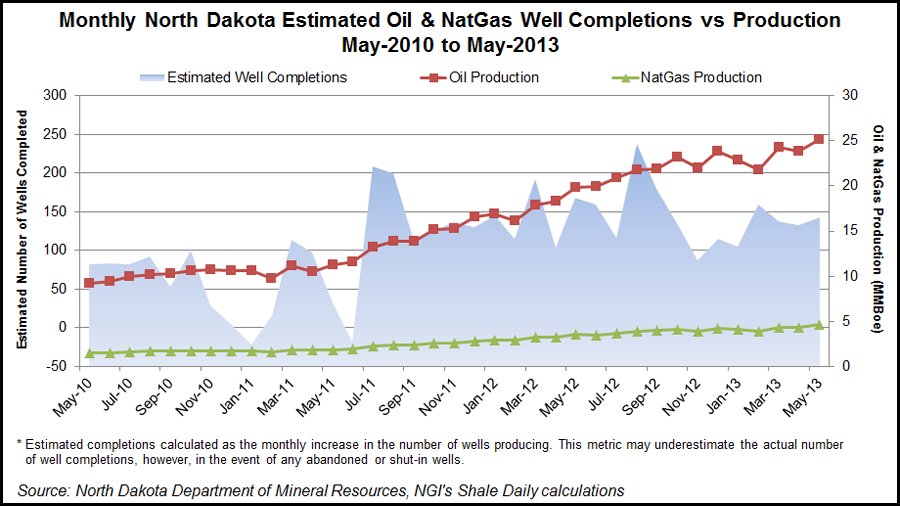NGI Archives | NGI All News Access
North Dakota Production Soars While Well Completions Slow
Driven by the Bakken Shale play, North Dakota’s oil and natural gas production continued to soar in May, but well completion rates were slowing amid a continued boom for drilling new wells, according to the latest monthly report from the state’s Department of Mineral Resources (DMR).

According to the most recently compiled monthly statistics, oil and gas production set all-time highs in May at 25.1 million bbl (810,129 b/d) and 27.8 Bcf (900 MMcf/d), respectively, while setting an all-time mark for producing wells at 8,915, an increase of 143 more than in April.
Natural gas production rates continued to outpace oil production growth rates, with gas hitting 4.5%, compared to oil’s 2.1%. “This is consistent with the Bentek study that shows gas/oil ratios increase as wells age [see Shale Daily, May 16],” said DMR Director Lynn Helms. He reiterated that the state’s shallow gas exploration is not economic at near-term gas prices.
Natural gas delivered to Northern Border Pipeline at Watford City, ND, was down by 31 cents to $3.20/Mcf in May, and additions to gathering and processing for the Bakken high-liquids-content gas were what Helms called “catching up,” although the portion of flared gas stubbornly remained at 29%.
“Drilling rigs continue to outpace completion crews,” said Helms, noting that the drilling rig count rose by only one from April through June. “The average number of days to drill a well from spud to total depth is at just under 22, but the average number of days from total depth to initial production has increased to 92 days.”
Helms cited a number of contributing factors for the slowing of completions, including load restrictions that remained in place because May turned out to be the wettest on record, closing roads and restricting traffic; continuing uncertainty regarding federal policies on taxation and hydraulic fracturing regulations; and federal budget pressures calling for elimination of deductions for intangible drilling costs and the depletion allowance.
“At the end of May there were about 500 wells waiting on completion services, an increase of 10,” Helms said.
© 2024 Natural Gas Intelligence. All rights reserved.
ISSN © 2577-9877 | ISSN © 2158-8023 |

